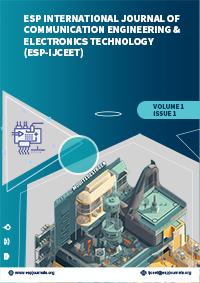ESP International Journal of Communication Engineering & Electronics Technology (ESP-IJCEET)
Citation :
Lakshmi Durga Nujiveeti, R Vinay Kumar, 2023. "A Low Power 6T SRAM using Sleep Power Reduction Technique" ESP International Journal of Communication Engineering & Electronics Technology (ESP- IJCEET) Volume 1, Issue 2 : 20-24
.Abstract :
One type of memory component is static random access memory (SRAM). SRAM is in high demand in SOCs due to its unique data-retention capabilities. For the sake of anticipating future needs, this memory part became the subject of study. The importance of power leakage in chip design has grown as SRAM densities have increased. Recent years have seen significant progress in SRAM's ability to reduce power consumption. Mary methods have been developed to provide both dynamic and static power reduction. Today's memory technology is primarily concerned with improving speed and reducing power consumption. In light of this, the research focuses on a low power SRAM that employs a hybrid sleep transistor approach and compares it to traditional SRAM in terms of delay: power dissipation and power delay product(PDP). Using this method, the delay and power requirements of SRAM are decreased. All parameters and stimulations are based on the TANNER MENTORGRAPHICS 250nm technology.
References :
[1] Borkar S. Design challenges of technology scaling. IEEE Micro 1999;19(4):23.
[2] www.itrs.com/ Indian Technology Roadmap for Semiconductor
[3] Yung-Do Yang and Lee-Sup Kim, ―A Low-Power SRAM Using Hierarchical BitLine and Local Sense Amplifiers‖ IEEE Journal of solid state circuits, Vol.40, No. 6,June 2005
[4] Shilpi Birla, Neeraj Kr. Shukla, Debasis Mukherjee and R.K Singh “Leakage Current Reduction in 6T Single SRAM Cell at 90nm Technology” IEEE International Conference on Advances in computer Engineering.
[5] Atluri. Jhansi rani, K. Harikishore et al. 2012.Designing and Analysis of 8 Bit SRAM Cell with Low Subthreshold Leakage Power. International Journal of Modern Engineering Research (IJMER). 2(3): 733-741.
[6] Device Bias Technique to Improve Design Metrics of 6T SRAM Cell for Sub threshold Operation
[7] Manish Kumar, Md. Anwar Hussain, Sajal K. Paul. 2013. New Hybrid Digital Circuit Design Techniques for Reducing Subthreshold Leakage Power in Standby Mode. Circuits and Systems. 4, 75-82.
[8] Neeraj Kr. Shukla, Shilpi Birla, R.K. Singh, and Manisha Pattanaik, “Speed and Leakage Power Trade-off in Various SRAM Circuits”, International Journal of Computer and Electrical Engineering (IJCEE), Singapore, VOl.3, No.2, Apr. 2011,pp. 244- 249.
[9] L. Chang, D. Fried, R. Dennard, et al., “Stable SRAM cell design for the 32 nm node and beyond,” Symp. VLSI, Dig. Of Tech. Papers, pp. 128-129, 2005.
[10] B.S Deepak subramanyan and Adrian Nunez, “Analysis of subthreshold Leakage Reduction in CMOS Digital Circuits”, Proceedings of 13th NASA VLSI Symposium, post Falls, IDAHO USA, June 5-6, 2007 pp 1-8.
[11] Weste N, Eshraghian K. “Principles of CMOS VLSI Design: A System Perspective”, 2nd edition. New York: Addison-Wesley, 1993.
Keywords :
SRAM, System on chip (Soc), MTCMOS, Scaling.


